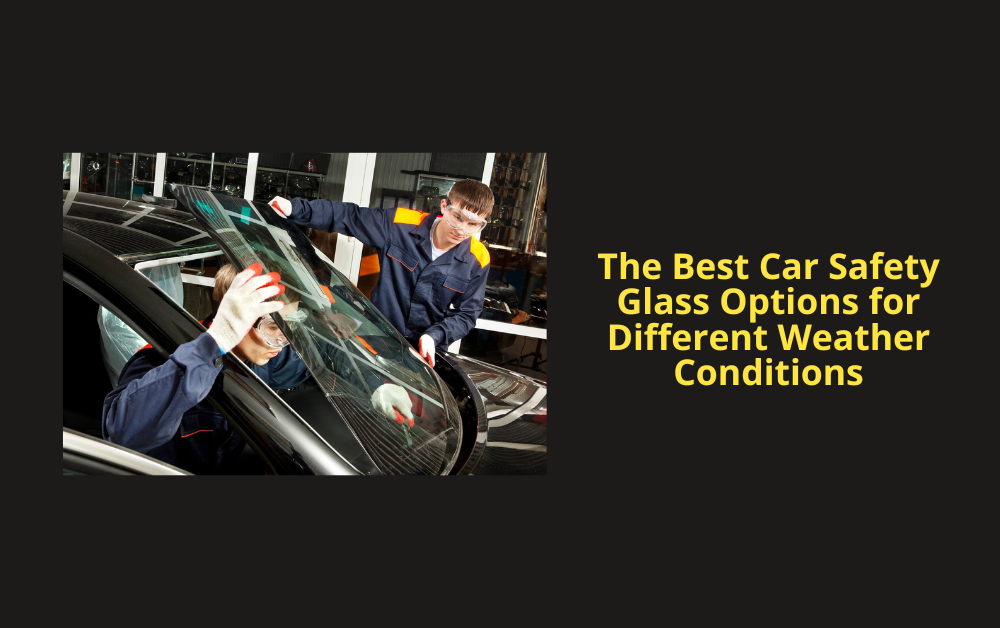When it comes to driving, safety should always be a top priority. One often overlooked but crucial aspect of car safety is the type of glass used in your vehicle. Car safety glass is designed not only to provide a clear view of the road but also to protect the driver and passengers from various hazards. Different weather conditions can have a significant impact on visibility and safety, making it essential to choose the right type of car safety glass for each situation.
In this blog, we’ll explore the best car safety glass options for different weather conditions, helping you make an informed decision that enhances both your driving experience and safety.
Understanding Car Safety Glass
Before diving into the specific types of car safety glass suited for different weather conditions, let’s first understand what car safety glass is and why it’s essential.
Car safety glass is specially designed to minimize injury during accidents or impacts. There are two primary types of car safety glass:
- Tempered Glass: This type of glass is heat-treated to increase its strength. When broken, tempered glass shatters into small, blunt pieces that are less likely to cause injury.
- Laminated Glass: Laminated glass consists of two or more layers of glass bonded together with a plastic interlayer. This interlayer holds the glass together upon impact, preventing it from shattering into sharp pieces.
Both types of safety glass are used in different parts of a vehicle, with laminated glass typically found in windshields and tempered glass commonly used in side and rear windows.
The Importance of Choosing the Right Car Safety Glass for Different Weather Conditions

Weather conditions play a significant role in driving safety. Factors such as rain, snow, fog, and extreme temperatures can impair visibility, making it harder to navigate the road safely. Choosing the right car safety glass can help mitigate these challenges, providing better protection and visibility in adverse weather conditions.
1. Car Safety Glass for Rainy Conditions
Rain is one of the most common weather conditions drivers face, and it can significantly reduce visibility. Rainwater on the windshield can distort the view, making it difficult to see the road, other vehicles, and pedestrians. Here are the best car safety glass options for rainy conditions:
a. Water-Repellent Laminated Glass
Water-repellent laminated glass is an excellent choice for rainy weather. This type of glass is treated with a hydrophobic coating that causes water to bead up and roll off the surface quickly. This reduces the amount of water that sticks to the glass, improving visibility and reducing the need for wiper use.
b. Heated Windshields
A heated windshield is another great option for rainy conditions. It features embedded heating elements that help prevent fogging and remove condensation from the glass. This ensures a clear view, even in heavy rain, and can be particularly useful during the transition between warm interiors and cold exteriors.
2. Car Safety Glass for Snowy and Icy Conditions
Driving in snowy or icy conditions presents unique challenges, including reduced visibility due to snow accumulation on the windshield and ice formation. Here are the best car safety glass options for these conditions:
a. Heated Windshields
As mentioned earlier, heated windshields are highly effective in snowy and icy conditions. The heating elements embedded in the glass help melt snow and ice, keeping the windshield clear and reducing the need for manual scraping. This not only improves visibility but also saves time and effort on cold winter mornings.
b. Laminated Glass with Anti-Frost Coating
Laminated glass with an anti-frost coating is another excellent option for cold weather. This type of glass is treated with a special coating that prevents frost from forming on the surface, ensuring a clear view even in freezing temperatures.
3. Car Safety Glass for Foggy Conditions
Fog can be particularly dangerous for drivers, as it significantly reduces visibility and can create a sense of disorientation. The right car safety glass can help improve visibility in foggy conditions:
a. Anti-Fog Coated Glass
Anti-fog coated glass is designed specifically to combat the challenges of foggy weather. The glass is treated with a special coating that prevents moisture from condensing on the surface, which helps maintain a clear view even when the humidity is high.
b. Heated Windshields
Once again, heated windshields prove their worth in foggy conditions. The heat prevents fog from forming on the inside of the windshield, providing a clear and unobstructed view of the road.
4. Car Safety Glass for Hot and Sunny Conditions
Hot and sunny weather can present its own set of challenges, including glare, UV exposure, and interior overheating. Here are the best car safety glass options for hot and sunny conditions:
a. UV-Blocking Laminated Glass
UV-blocking laminated glass is designed to protect the interior of your vehicle and its occupants from harmful ultraviolet (UV) rays. This type of glass can block up to 99% of UV radiation, reducing the risk of skin damage and preventing the car’s interior from fading. Additionally, it helps keep the cabin cooler by reducing the amount of heat that enters the vehicle. However, after the application of the uv shield, the workshop can use car paint protection film PPF Singapore to protect the overall exterior for longer run.
b. Tinted Safety Glass
Tinted safety glass is another great option for hot and sunny conditions. The tint reduces glare from the sun, making it easier to see the road. It also helps keep the interior cooler by blocking some of the sun’s heat. However, it’s important to ensure that the tint level complies with local regulations, as excessively dark tints can impair visibility, especially at night.
5. Car Safety Glass for Windy and Dusty Conditions
Driving in windy and dusty conditions can be challenging, as dust and debris can obscure visibility and potentially damage your vehicle’s glass. Here are the best car safety glass options for these conditions:
a. Laminated Glass with Protective Coating
Laminated glass with a protective coating is ideal for windy and dusty conditions. The protective coating helps prevent scratches and damage from debris, ensuring that your glass remains clear and intact. Additionally, the laminated structure of the glass provides extra strength, reducing the risk of shattering if hit by larger debris.
b. Self-Cleaning Glass
Self-cleaning glass is a relatively new innovation that can be particularly useful in dusty conditions. This type of glass is treated with a special coating that breaks down organic dirt and allows it to be washed away by rain or wiped off easily. This helps maintain visibility by keeping the glass clean even in harsh conditions.
6. Car Safety Glass for Mixed Weather Conditions
In many regions, weather conditions can change rapidly, requiring a versatile solution that can handle a variety of scenarios. Here are the best car safety glass options for mixed weather conditions:
a. All-Weather Laminated Glass
All-weather laminated glass is designed to perform well in a variety of conditions, from rain to sun to snow. It typically combines several features, such as UV protection, anti-fog coating, and durability, making it a reliable choice for drivers who experience changing weather conditions frequently.
b. Adaptive Glass
Adaptive glass, also known as smart glass, is an innovative solution that can adjust its properties based on the current weather conditions. For example, it can darken in bright sunlight to reduce glare, become more transparent in low light, and even heat up to prevent frost or fog. While adaptive glass is still a premium option, its versatility makes it an excellent choice for drivers who need a multi-functional solution.
Maintenance Tips for Car Safety Glass
Choosing the right car safety glass is just the first step; proper maintenance is also crucial to ensure optimal performance and longevity. Here are some tips to keep your car safety glass in top condition:
1. Regular Cleaning
Regularly clean your car safety glass to remove dirt, dust, and debris that can impair visibility. Use a soft cloth and a mild glass cleaner to avoid scratching the surface. For laminated glass, avoid using harsh chemicals that could damage the interlayer.
2. Inspect for Damage
Regularly inspect your car’s glass for cracks, chips, or other damage. Even small chips can expand over time, especially in extreme weather conditions, leading to more significant issues. Address any damage promptly to prevent it from worsening.
3. Avoid Extreme Temperature Changes
Sudden temperature changes can cause car safety glass to crack or shatter. Avoid pouring hot water on a frosted windshield, and try to park your car in shaded areas during extreme heat. Use sunshades or car covers to protect the glass from intense sunlight.
4. Replace Worn Wiper Blades
Worn or damaged wiper blades can scratch your windshield, reducing visibility and compromising the integrity of the glass. Replace your wiper blades regularly, especially before the rainy season, to ensure they are functioning properly.
5. Apply Protective Coatings
Consider applying protective coatings, such as water-repellent or anti-fog treatments, to your car safety glass. These coatings can enhance visibility in challenging weather conditions and make it easier to clean the glass.
Conclusion
Choosing the right car safety glass for different weather conditions is essential for ensuring a safe and comfortable driving experience. Whether you’re dealing with rain, snow, fog, or intense sunlight, the right type of glass can significantly enhance your visibility and protect you from potential hazards.
By considering factors such as water repellency, UV protection, anti-fog properties, and durability, you can select the best car safety glass for your specific needs. Additionally, regular maintenance and proper care will help extend the life of your car safety glass and ensure that it continues to provide the protection and clarity you need.
Remember, when it comes to driving, safety should always come first. Investing in high-quality car safety glass is a small but significant step towards safeguarding yourself and your passengers on the road. Whether you’re navigating through a stormy night or cruising under a bright summer sun, the right glass can make all the difference in your driving experience.
Note :- Read more related blogs at https://storysupportpro.com/



